- TOP
- Gardens & Shops
- garden
- paid garden
- Hitachi Seaside National Government Park - Famous for its breathtaking view of nemophila flowers
Hitachi Seaside National Government Park – Famous for its breathtaking view of nemophila flowers
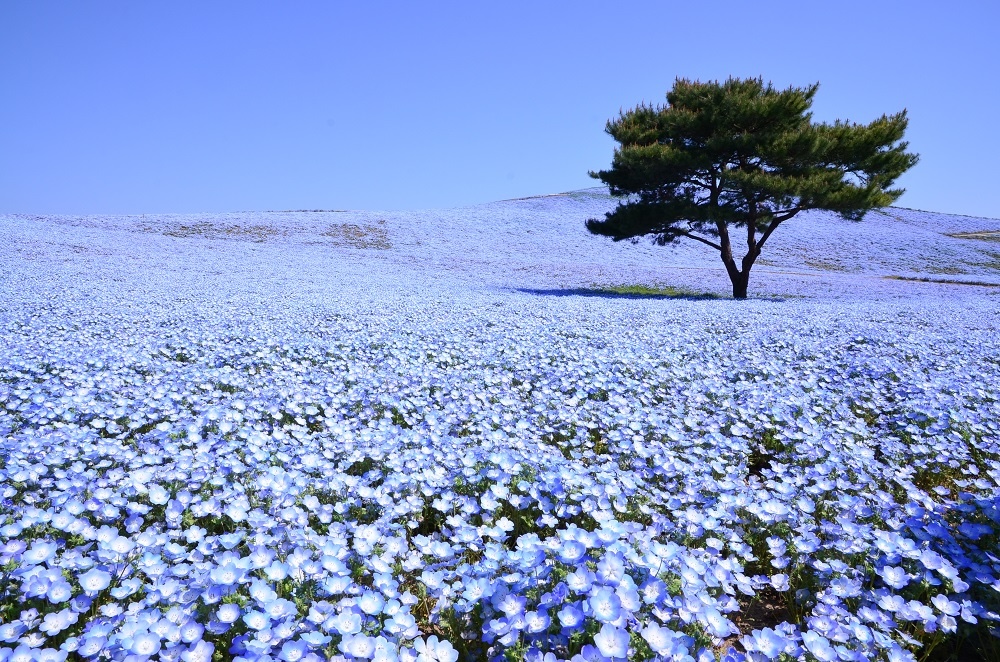
In Japan, where the four seasons are distinctly marked, there are many gardens that attract attention from around the world for their lush landscapes, wide range of plants, and technical skills in making flowers bloom beautifully. Across the country, there are many blooming spots that impress visitors. Let us guide you to breathtaking tourist gardens that you should visit at least once in your lifetime. This time, we’re introducing the charm of Hitachi Seaside National Government Park (hereafter “Hitachi Seaside Park”), best known for its stunning nemophila blooms.
Contents
ToggleHitachi Seaside Park: A Vast and Scenic Urban Oasis
Opened in 1991, Hitachi Seaside Park is a vast urban park with a total area of approximately 350 hectares(865ac), of which about 200 hectares(494ac) are currently open to visitors.
Throughout the year, a variety of flowers bloom in the park, and the park also features a forest adventure playground, a barbecue area (reservation required), the “Pleasure Garden” amusement area with rides and attractions, cycling paths, and spaces for nature observation.
With so much to explore, it’s nearly impossible to see everything in a single day. Be sure to check the park map beforehand and decide which areas you want to focus on.
One of the park’s defining features is its use of the vast grounds to plant large swathes of seasonal flowers, creating dynamic, landscape-wide displays. In particular, nemophila in spring and the kochia bushes from summer to autumn have become iconic, must see attractions.
Nemophila May Be the Star of Spring,
But Don’t Overlook the 250,000 Tulips!
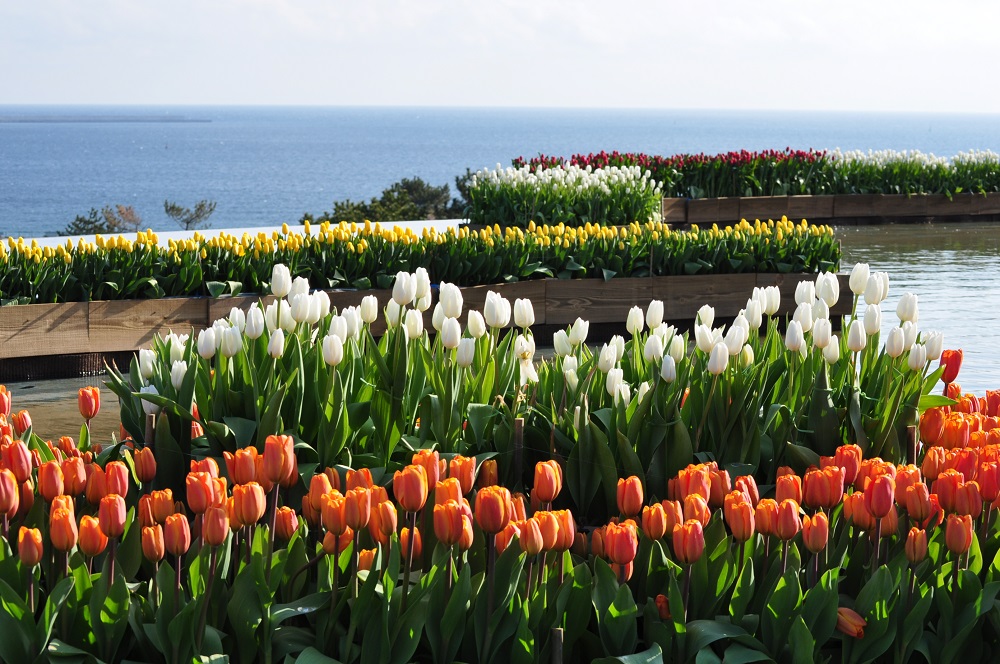
At Hitachi Seaside Park, tulips begin blooming as early as January—even in the middle of winter. These are called “Ice Tulips,” grown from bulbs that have been specially chilled before planting.
Ice Tulips are known for blooming in the middle of winter and for their exceptionally long flowering period. Around 15,000 Ice Tulips bloom beautifully by the pond in front of the Glass House. For gardeners, winter is a season of longing for the sight of blooming flowers. A visit to see the Ice Tulips is the perfect way to soothe that craving—and to look forward to the coming of spring.
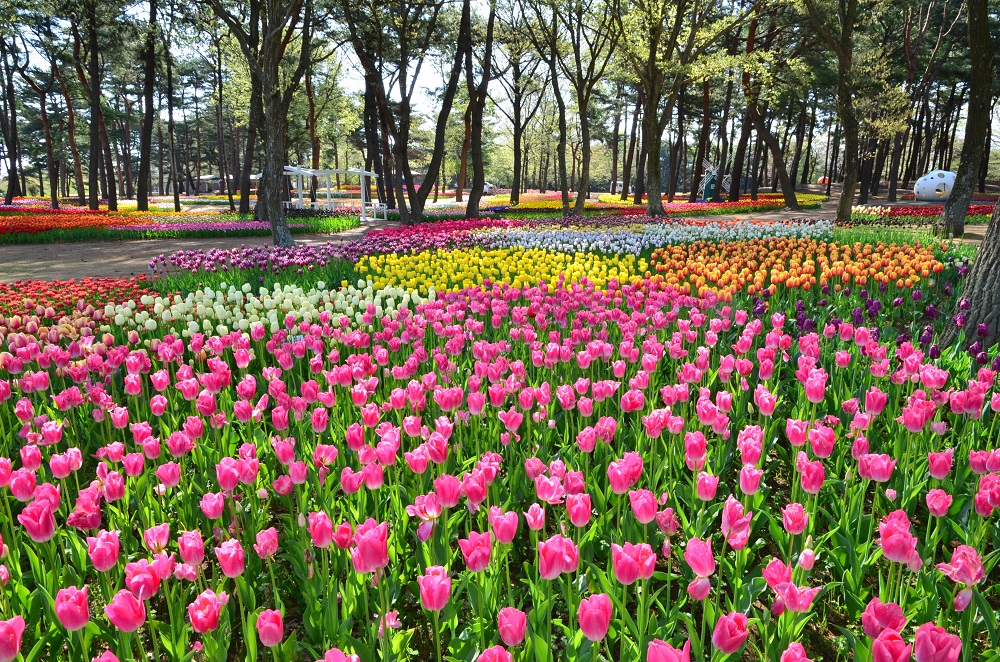
The highlight of spring at the Hitachi Seaside Park is undoubtedly the tulips, which reach their peak bloom from mid to late April. In the “Tamago no Mori Flower Garden,” approximately 250,000 tulips of about 240 varieties come into bloom. A wide range of different types are featured each year, making it a favorite spot for many returning visitors. The tulips are carefully planted in a blend of early- and late-blooming varieties, allowing the scenery to change with the passage of time.
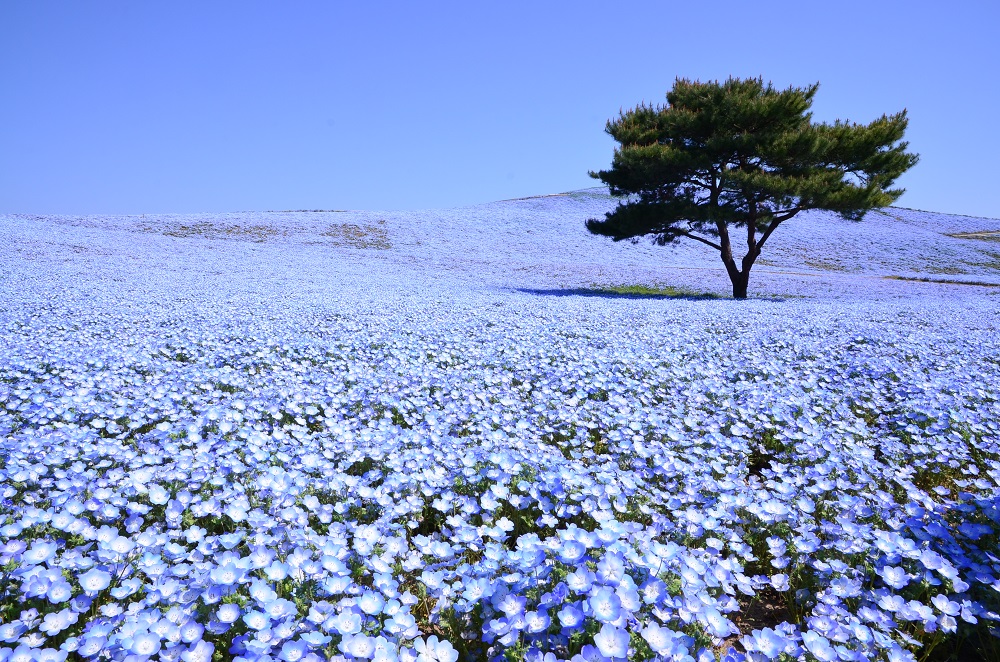
When people think of Hitachi Seaside Park, they often think of nemophila. This image has become well established over the years. The best time to see them is from mid-April to early May. On “Miharashi Hill” within the park, about 4.5 million Nemophila menziesii (commonly known as ‘Baby Blue Eyes’) are planted, creating a breathtaking sea of blue. Surrounded by the blues of the sky, the sea, and the Nemophila, it’s a refreshing and unforgettable sight that everyone should experience at least once.
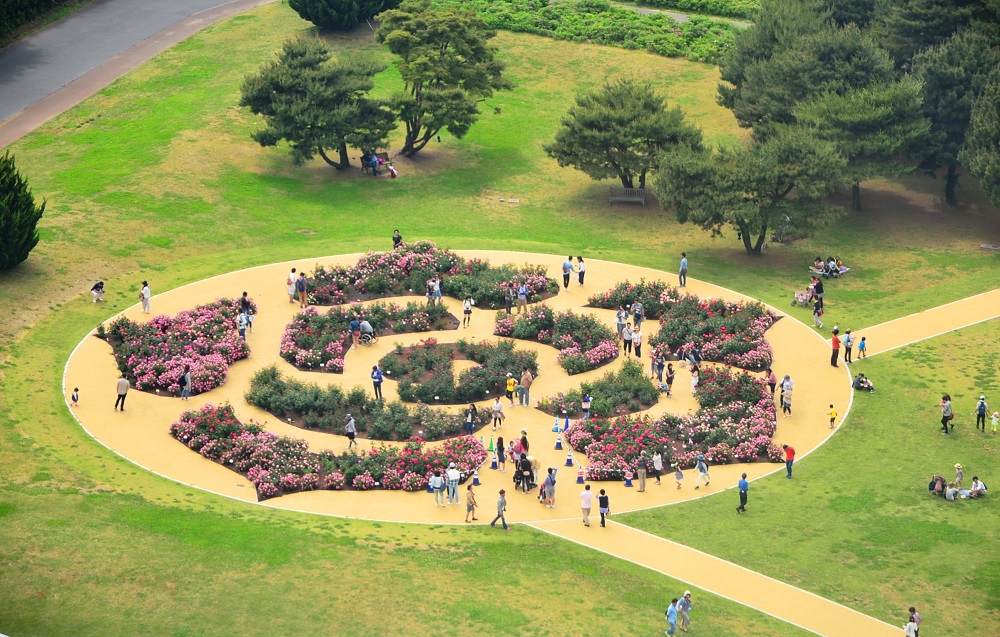
The “Hitachi-Rose Garden”, located in the Hitachi Seaside Park, features 3,400 roses of about 120 varieties. The best time to see the roses is from mid-May to early June in spring, and from late October to early November in autumn.
The “Rose Relief Garden” in the above photo is designed to resemble a single large rose, with walking paths forming the shape of petals. It becomes a striking visual highlight when viewed from the park’s Giant Ferris wheel.
In addition, about 1,600 Rugosa roses—a wild species and one of the original ancestors of modern roses—are planted in the garden. Ibaraki Prefecture marks the southernmost point along the Pacific coast where they grow naturally, making them especially significant here.
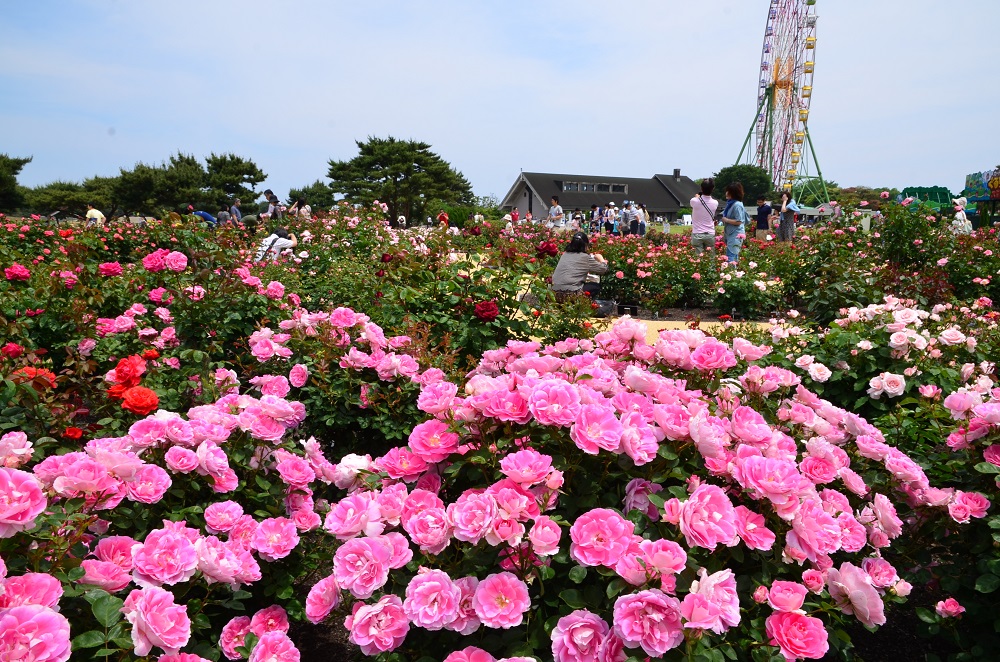
During the rose season, the “Ibaraki Rose Festival” is held. Visitors can take part in a variety of events, including the “Hitachi Rose Garden Tour,” where knowledgeable guides share insights about the roses. There are also photo lessons, concerts, and hands-on craft workshops inspired by roses.
At the same time as the roses bloom, visitors can also enjoy California poppies near the BMX course, as well as linaria and Shirley poppies in the “Grassland Flower Garden”. Be sure to visit these areas, too.
Enjoy Sunflowers and Fluffy Kochia in Summer!
In Autumn, the Scarlet Kochia Hills Steal the Show
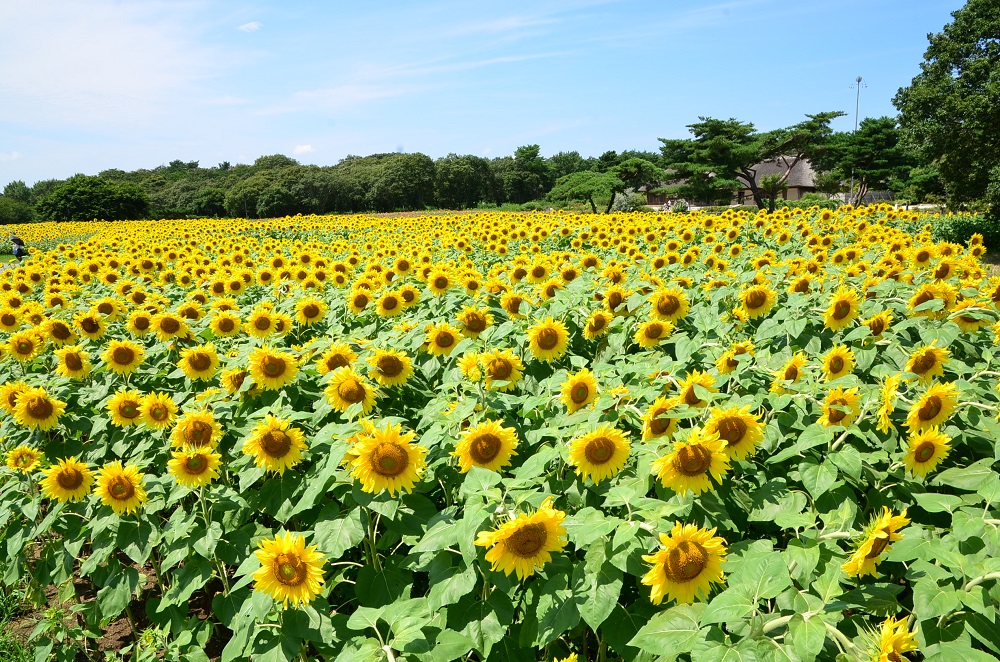
In mid-August, sunflowers become one of the park’s main attractions. At “Miharashi no Sato,” you can enjoy around 30,000 sunflowers blooming across a 4,700m2(approx.1.2ac.) field. A “Sunflower Maze” is also created, allowing visitors to wander through the sunflower field while aiming for the goal.
Meanwhile, at the “Fountain Plaza Flower Garden”, around 40 different varieties of sunflowers are planted. It’s a great place to explore the diversity in color, shape, and size—and maybe even discover a variety you’d like to grow yourself.
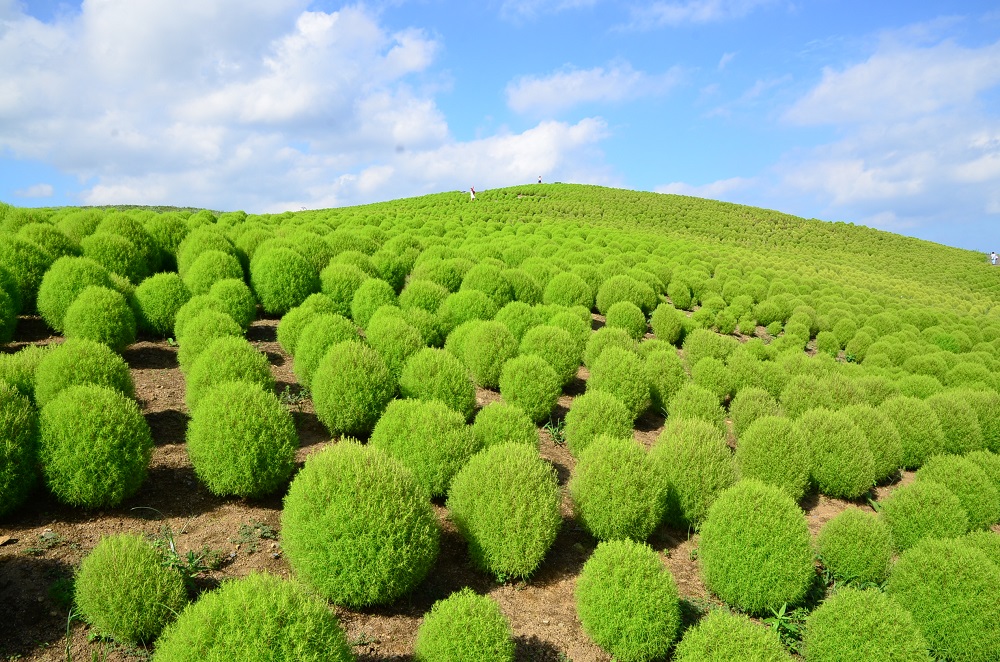
In early July, about 32,000 green kochia bushes cover the “Miharashi Hill” area of Hitachi Seaside Park. Don’t you think their fluffy round shape is kind of adorable? Be sure to snap some photos with these vibrant green puffs against the bright blue sky—it’s guaranteed to be Instagram-worthy!
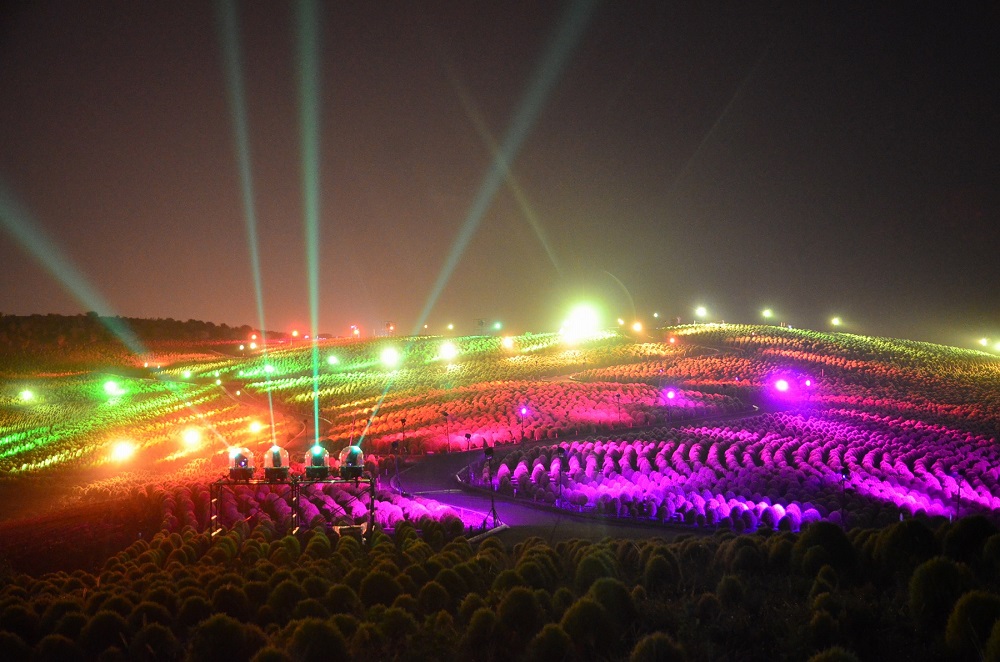
For about a week in mid-August, the “Miharashi Hill” area—where the kochia bushes grow—is open at night for a limited time. The highlight of the event is the colorful LED lights with lively background music.Each year features a different theme, creating a magical experience of lights and sound. Don’t forget to stop by the special gourmet area, where a variety of food stalls add to the festive atmosphere.
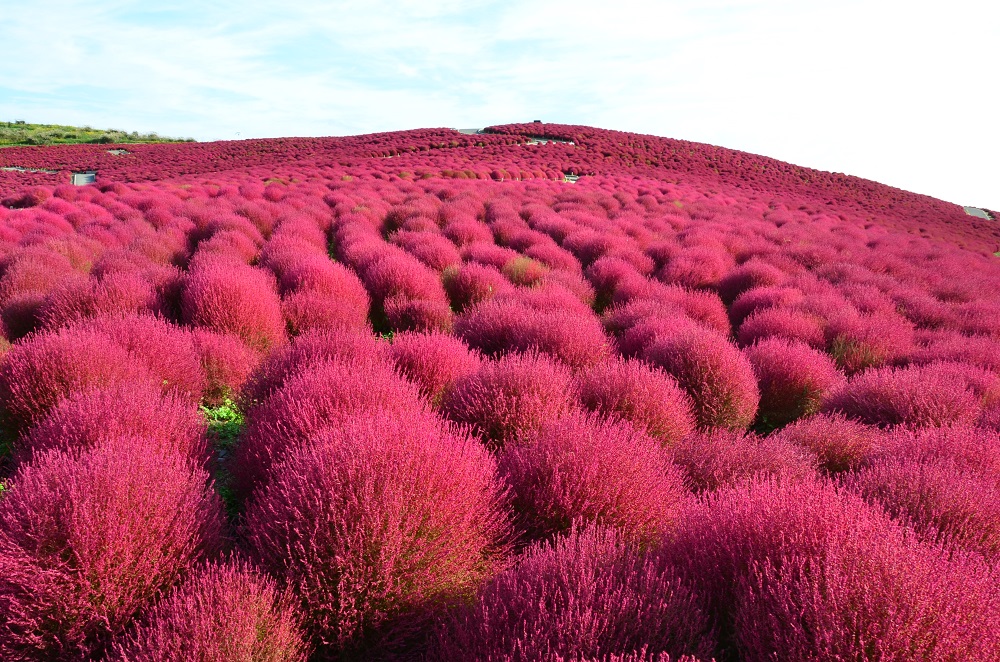
And the kochia truly comes into its own from mid-October, when its bright green transforms into a stunning deep red. The gently sloping hill, completely covered in vibrant red, is well worth seeing. Be sure to visit in autumn to see the kochia.
Around the same time, graceful autumn flowers such as red, white, and pink cosmos, as well as Japanese pampas grass and silvergrass, also come into full bloom.
Explore the Spacious Park Aboard the Seaside Train!
Enjoy Stylish Restaurants and Casual Cafés Throughout the Park
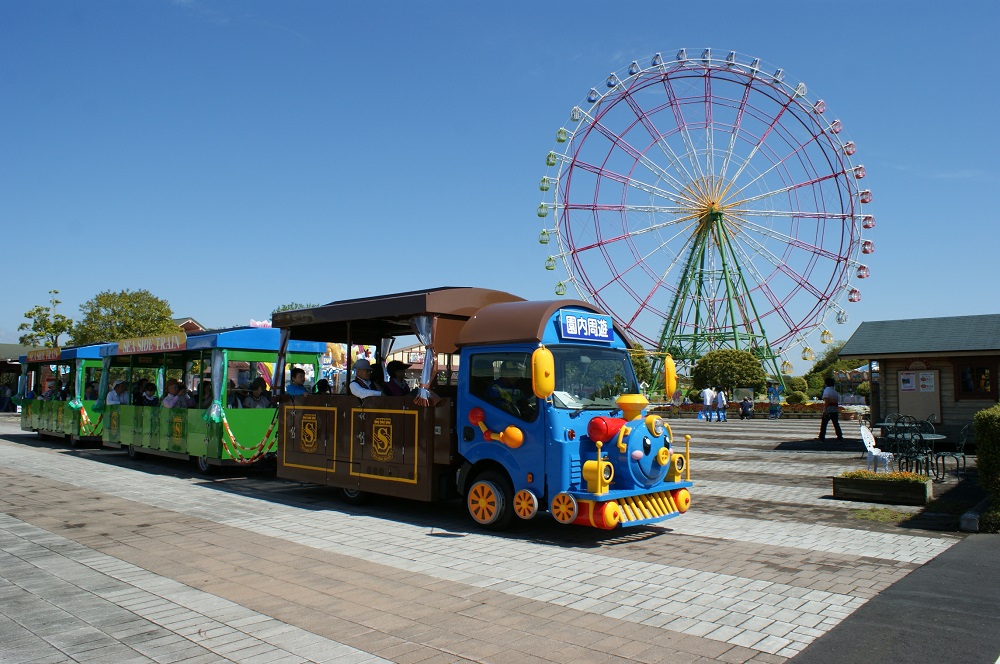
At Hitachi Seaside Park, the Seaside Train loops around the park with 9 convenient stops. Visitors aged 3 and up can purchase a one-day pass for 600 yen, which allows for unlimited hop-on, hop-off rides throughout the day.
Given the park’s expansive grounds, it’s an ideal option for those who aren’t used to walking long distances. The whole ride takes about 40 minutes, so it’s a great idea to ride the train first and get a feel for the layout before deciding which areas to explore.
Please note: pets are not allowed on the Seaside Train.
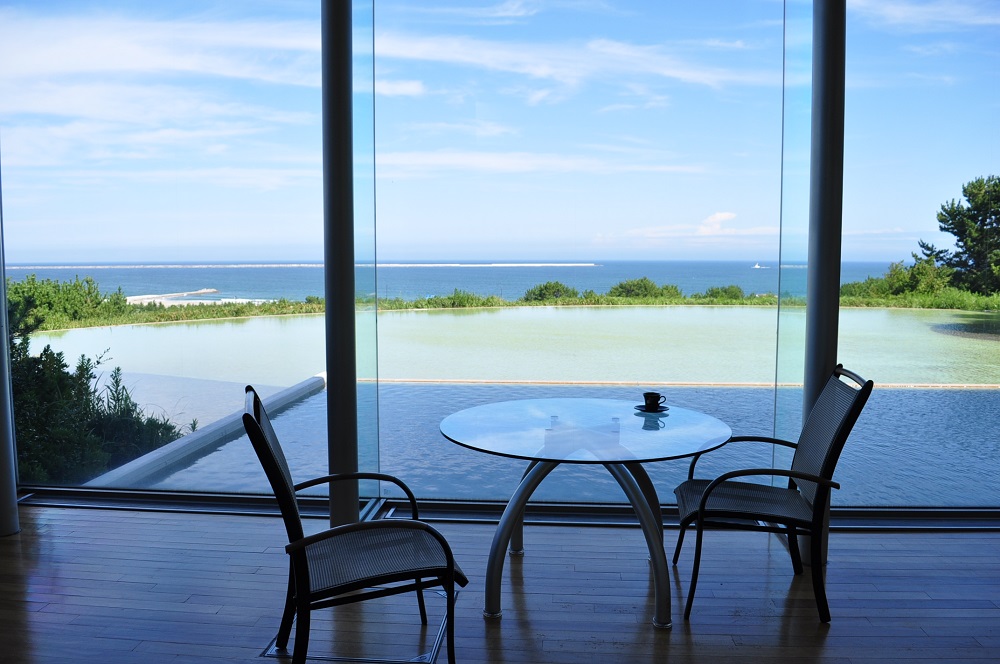
There is one restaurant and seven casual eateries, including food stands and cafés, in Hitachi Seaside Park.
The photo shows the Sea Side Café at Glass House, a glass-walled terrace café offering scenic ocean views.
Opening hours are from 9:30 AM until an hour before the park closes (depending on the season). The last order is taken an hour and 15 minutes before closing.
The Sea Side Café offers a variety of menu items, including Glass House Sobameshi (noodle rice) and Glass House Shrimp Pilaf (each ¥800), chiffon cake (¥650), Hitachino Honey Donuts (¥450), flower-inspired soft-serve ice cream (¥620), and nemophila-inspired ice cream (¥550).
While the park has plenty of dining options, visitors are also welcome to bring their own food and drinks. Enjoy a relaxing break under the open sky with a picnic lunch or some snacks!
Information
Hitachi Seaside Park
Address: 605-4 Onuma-aza, Mawatari, Hitachinaka, Ibaraki/Japan
Call: Hitachi Seaside Park Office 029-265-9001
Pleasure Garden (Amusement Park) 029-265-8185
Official Website: https://hitachikaihin.jp/en/
Access:
[By Train]
・To Katsuta Station
<Form Shinagawa>
Around 1 hour 15 minutes by JR Joban Line Limited Express train from Shinagawa to Katsuta Station.
< Form Iwaki>
Around 1 hour by JR Joban Line Limited Express train from Iwaki to Katsuta Station.
・From Katsuta Station
< Regular Buses>
Around 15 minutes to the West Gate or 20 minutes to the South Gate by bus from Katsuta Station East Exit Bus Stop No.2.
Special non-stop bus from Katsuta Station East Exit to West Gate (Spring/Autumn Peak Season only)
・From Tokai Station
Around 30 minutes to the West Entrance from Tokai Station East Exit Bus Stop No. 1.
< Change trains to the Minato line, Hitachinaka Seaside Railway>
After the transfer at Katsuta, ride the train for 30 minutes to Ajigaura Station. From there on the park can be reached in 10 min. by bus or taxi. Take a local bus called Smile Aozora to the Kaihin Koen Nishiguchi Bus Stop. Also limited seasonal bus services and others are available between Ajigaura Station and Kaihinguchi
(Seabreeze Entrance) on Saturdays, Sundays and public holidays in spring and autumn. Alternatively walk 20 min. from Ajigaura Station to the South Entrance of the Park.
【Taxi】
About 15 minutes from Katsuta Station East Exit to Hitachi Seaside Park West Gate.
【By Expressway Bus】
・From Tokyo Station
Around two hours by expressway bus bound for Katsuta/Tokai from Tokyo Station Yaesu South Exit.
【By Car】
・From the Tokyo area
Joban Expressway → Kita-Kanto Expressway → Hitachinaka Toll Road
Exit at Hitachi Seaside Park IC
・From the Tohoku area
Approximately 15km from Hitachi Minami Ota IC
Approximately 13km from Tokai Smart IC
※For a detailed map, please click here.
Days Closed:
Every Tuesday (when Tuesday is a national holiday, the park will be closed on the next weekday
December 31 and January 1
From the day before the first Tuesday in February to the following Friday.
Opening Hours:
From March 1 to July 20 9:30-17:00
From July 21 to August 31 9:30-18:00
From September 1 to October 31 9:30-17:00
From November 1 to the end of February 9:30-16:30
Admission:
・Standard Period
Adults(15 and over): 450 yen
Seniors(65 and over): 210 yen
・Peak Season(apply in April/May and October.)
Adults(15 and over): 800 yen
Seniors(65 and over): 560 yen
Parking Fees:
Standard Vehicle: 600yen
Two-wheeled Vehicles: 300yen
Large vehicles (buses, etc.): 1,800yen
Credit
Interview & Text / Osada Setsuko

Writer&Editor.
Specializes in lifestyle topics, focusing on gardening, interior design, and housing.
Became independent and started working as a freelancer after working for an editorial production company for about 10 years from 1994.
Enjoying gardening with balcony garden.
Translation / Garden Story Editorial Team
Latest Articles
-
garden
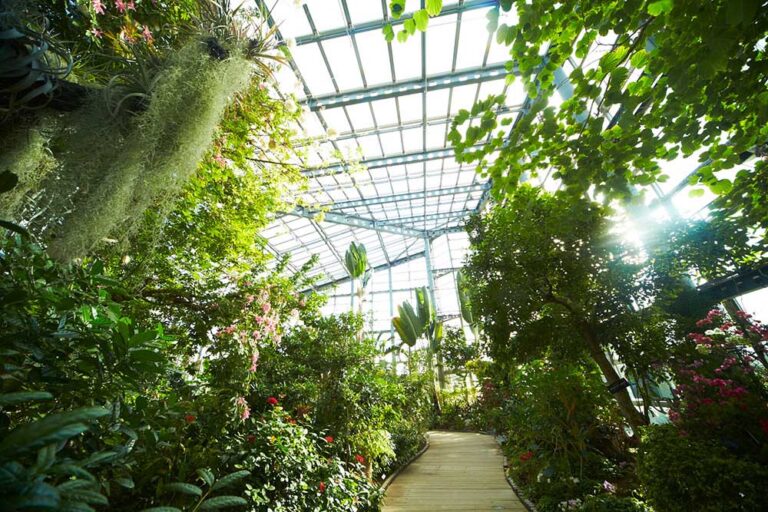
Sakuya Konohana Kan―A Greenhouse Botanical Garden Full of Hands-On Experiences
Sakuya Konohana Kan conservatory is a two-story greenhouse made of glass and steel, and one of the largest botanical gardens in Japan. In winter, when greenery becomes scarce, strolling through its w…
-
garden
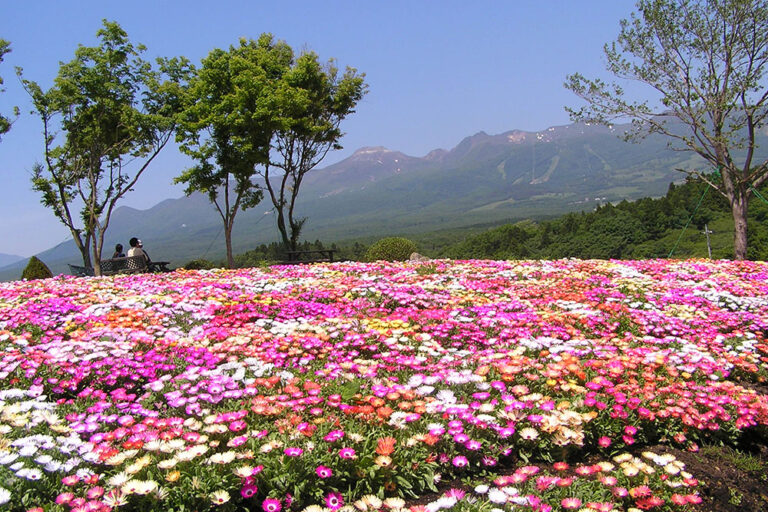
Nasu Flower World―Breathtaking Fields of Blossoms
Nasu Flower World is a tourist garden located in the popular resort area of the Nasu Highlands. Making full use of its vast grounds, the garden features sweeping mass plantings of seasonal flowers, c…
-
garden
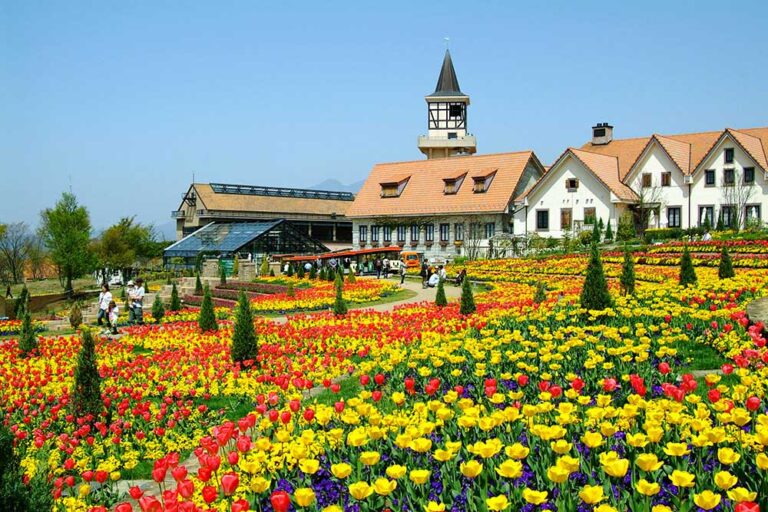
Heidi’s Village―A Beloved Theme Park and Flower Paradise
Heidi’s Village, known as the theme park of the classic anime Heidi, Girl of the Alps, is also a popular tourist destination with the charm of a flower park. Among its highlights is Japan’s longest “…
